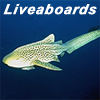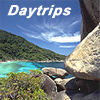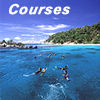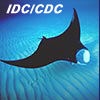Reef Ecology Guide Phuket Thailand - Sponges & Marine Worms
SPONGES (Spongia)

Sponges have the least complex body structure of all multi-celled creatures. A typical sponge is composed of an outer layer of tissue and a fibrous inner layer impregnated with numerous glass-like slivers of silica or calcium carbonate.
The outer surface is riddled with small openings, joining a complex network of internal canals, through which water circulates. The inner canals are lined with special feeding cells, which are equipped with thread-like tails. Vigorous movements of these tails create a current that moves food-laden water through the sponge.
A typical sponge pumps water equal to 5 times its own volume every minute. For a football-sized sponge this translates to several thousand liters each day.
Sponges feed on micro plankton and bacteria. Many sponges live, same as corals, in symbiosis with algae in their living tissues.
GREAT VASESPONGE (Xestospongia testudinaria)
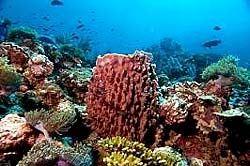 Length: to 70 cm
Length: to 70 cm
This species often hosts a variety of other organisms like crabs, shrimps, worms and fishes.
They use the sponge to gain access to plankton-rich currents passing above.
MARINE WORMS

Coral reefs are well and truly riddled with worms. Most reef worms are very inconspicuous. They live in a variety of microhabitats, particularly the myriad crevices and fissures that are common on the reef.
At the first glance FLATWORMS (Polyclads) can be easily mistaken for nudibranchs. They have a flattened, oval body and exhibit dazzling color patterns. Their bright colors probably warn predators that they are toxic or distasteful.
Most common worms inthe coral reefs around the Similan Islands are SEGMENTED WORMS (Polychaeta). They have a variety of shapes and life styles. Young worms settle on coral heads and secrete a tube that kills the underlying polyps. New coral growth quickly surrounds the tube. Meanwhile the worm occupant secretes additional tube material to keep pace with the coral. The worm lives permanently in this tube. Only the brightly colored, feather-like feeding tentacles protrude from its lair.
RIBBON WORMS (Nemertea) are also very common on Phuket's reefs. Their bodies are flattened and elongated. Most species are very small and although many are brightly colored, they mostly live hidden under rocks or dead corals or in soft bottom sediments.
ACORN WORMS (Hemichordata) live on sand or silt bottoms in U-shaped burrows. Although the animals themselves are not usually seen by divers, they deposit distinctive coils of sand above the burrow.
CHRISTMAS TREE WORM (Spirobranchus giganteus)
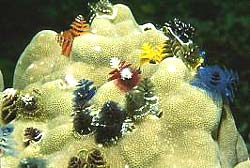 Height: to 3 cm
Height: to 3 cm
Because of its bright colors, this worm is very popular with divers. Settles in big colonies on hard corals of the species Porites.
This species is ultra sensitive to light and pressure changes. When disturbed they are quickly withdrawn into the tube.
Dive Asia - Phuket Thailand
Office Address: 8/30 Soi Yodsanee, Chalong, Phuket 83150, Thailand
Phone: +66 (0) 818948588 or 0899736005
Visit us at one of our Offices: (Google Map)
Email:
Website: www.diveasia.com
24 Hour Hotline: +66 (0) 818948588









